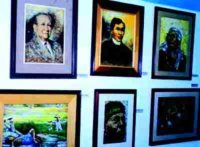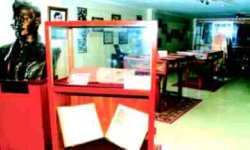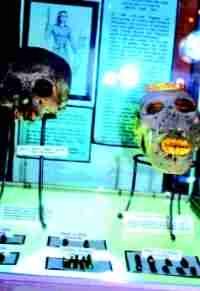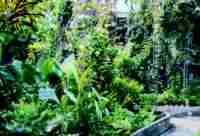Cebu Museums - Taking a Spin Through the Past
Take a tour through the Cebu museums and discover more about the 'Queen City of the South'
Cebu City Museum / Rizal Memorial Library
The Cebu City Museum at Fuente Osmeña, which was opened to the public on March 16, 1992, houses some 100 paintings, 50 sculptures, antique chinaware, furniture, and woodcarvings. There are also a few archaeological finds.
Patricia Perez, Chief of the Cultural and Historical Affairs Committee (CHAC) describes the Cebu City Museum as a place where mixed disciplines of the art converge.
A modern sculpture by Eliseo Pepito meets you at the door beside a mega-size 15th century Chinese vat donated by Fred Labra. As you move around the museum, you run into landscapes, portraits of well-known Cebuano figures and personalities, floral renditions, and murals. Antique chinaware from Carcar from the personal collections of Eva Mesa and Luther Galicano are stacked in a 40-year-old cabinet owned by Matilde Palicte.

The paintings of Professor Julian Jumalon are done with butterfly wings in the Lepido-mosaic style. |
The highlight of the Cebu City Museum is the detailed history of Cebu in 21 canvasses. The museum commissioned the best Cebuano painters to capture the city's history with authentic annotations following the approval of Prof. Resil Mojares, USC-Cebuano Studies Center and Prof. Julian Jumalon, an artist in his own right.
The paintings depict authentic Cebuano customs, costumes, and the lifestyle of Cebu from the 1500s to the Japanese Occupation in 1940s. Mario Vidal's "The Battle of Mactan, 1521," Jesse Rona's "Parian District, 1850," and "The Japanese Occupation, 1942," are some of the notable works on exhibit.
CAP Arts Center
The CAP Arts Center immortalizes Don Sergio Osmeña Sr., the grand gentleman of Philippine politics, and himself a maker of history.
Mary Abad, CAP Arts Center curator said that when the Osmeña house was put up for sale, big businessmen made a bid for it. The CAP bought the property but decided to retain its ambiance.
The first things one sees at the Center are black, antique in-laid furniture. A 1947 chandelier hangs over the dining area, a mute witness to many a state meeting with dignitaries from all over the world in attendance. The "MacArthur Room" transports you to the time when Don Sergio and his military advisers might have probably hatched the plan for some military strategies. The "Osmeña Room" contains Don Sergio's memorabilia. Here, you find the suits he wore while he was in exile in the U.S., a photo essay of his political career, his travels, and meetings with some of the most distinguished gentlemen he rubbed elbows with.
There is an old trunk full of sound system and communications paraphernalia which General Douglas MacArthur brought to Leyte and used as their communications system during the war. A shiny black Cadillac sits in the center of the room, the car that brought Don Sergio to many functions.
The CAP Arts Center added an annex that exhibits the works of amateur and professional artists of Cebu and the region.
Casa Gorordo Museum
A special project of Don Ramon Aboitiz is the Casa Gorordo Museum, situated in the middle of the Parian district, one of the old streets/districts in Cebu. Casa Gorordo is named after the owner of the house, Msgr. Juan Gorordo, Cebu's first bishop. Don Ramon acquired the house in 1980 and turned it into a museum.
Today, Casa Gorordo Museum is maintained by the Don Ramon Aboitiz Foundation, Inc. (RAFI). The Casa is built of pure tugas (molave), narra, and bayong (mahogany). A historical landmark, it is a two-storey building depicting 1860 architecture and the owner's distinct lifestyle.
The patio, located on the ground floor, serves as the waiting room for visitors. Part of the patio's furniture are bamboo sets, but a gallinera outshines them all, where chickens and other visitors' gifts for the family were safely tucked under while visitors waited. Near the patio is a basement where food, grains, and crops were stored.
You also find 18th and 19th century agricultural and household implements. A plow and other tools for land cultivation and harvesting show the evolution of farming technology. Large basins called duwang made of hard wood, four big palo-palo, clothes wringers and dryers, and a wooden plantsa, for ironing clothes complete the ensemble.
The second floor is equally fascinating. Eighty to 90 percent of the house, its furniture, and fixtures are all original. Intricate wood carvings on the ceiling divide the house into function rooms. In the sala are rattan sets and Vienna chairs, cabinets, tables, and beds made of narra or molave with delicate carvings. The dining room and the kitchen are showcases of gold and silver kubiertos (silverware), antique plates, tazas (cups), and even water jars, and cooking utensils of 18th century vintage.
Some of the more interesting items are: a giant grandfather clock, photographs of Cebu taken during the early American era, a Victor gramophone, four-poster beds, a crescent-moon-shaped mirror at the ladies' room said to bring good luck, and an 1890 Singer Sewing machine.
Would you believe that an 80-year old flower vine called the Bridal Bouquet still survives and provides shade to an azotea of the Casa?
USC Museum
The University of San Carlos Museum at P. del Rosario St. houses a wealth of information about the customs, traditions, beliefs, and mores of the Filipinos during the pre-Spanish and Spanish colonial era.
The different collections are so arranged that a viewer is informed not only about the diversity of the history and ethnology of Filipinos as a people but also about the natural beauty and bounty of Philippine flora and fauna as well.
The USC Museum started with a few collections of ethnographic and archaeological materials owned by Dr. Marcelino Maceda and Fr. Rodolf Rahman, SVD. The university acquired more collections and later expanded to make way for four galleries:
A. The Spanish Colonial Gallery showcases religious figures and items such as a 19th century carved altar of Cebu, the baptismal records of Cebu parish from August 26, 1843 to April 1856, and a coin collection minted in the Spanish colonies of Central and South America.
B. The Ethnographic Gallery shows the hunting and gathering skills of early tribal Filipinos. Various weapons and hunting tools of Filipinos from Lanao, Cotabato, and Sulu; different sizes of bows and arrow; and a blowgun or suput and udyong used to catch birds, monkeys, and wild pigs by the Negritos of Mindanao and Palawan are on display. Equally interesting are the bamboo musical instruments and the writing system of Indic Origin which survives among the Buhid and Hanunoo Mangyan of Mindoro and Tagabanua of Palawan; and costumes, amulets, and various betel chewing containers of tribal Filipinos.
C. The Archaeological Gallery explains the diverse burial practices among pre-Hispanic Filipinos showing their deep belief in life after death and their artistic talents. Notable finds are various burial urns and covers from caves and burial sites found in Menteng, Sultan Kudarat, Mindanao, circa 500 A.D. Containers for the ashes from Laguna, a cut log made into a boat coffin from Bohol, and jars and earthenware coffins from Negros Oriental also found their way into the gallery. The diggings include some 14th and 15th century earthenwares associated with Chinese and Southeast Asian export wares and a few antiques of the Sung and Ming Dynasties.
D. The Natural Science Gallery shows the vast resources of the country through its flora and fauna collection. Colorful mimetic butterflies and thousands of winged creatures; silkworm and its stages of silk production; a motley collection of moths, bees, flies, insects, and birds have been preserved for posterity. Philippine marine resources also found their niche at the gallery as well as igneous rocks, minerals, and gemstones.
USP Museum
The University of Southern Philippines Museum is probably the only institution in Central Visayas that has acquired a rich collection of memorabilia owned by the Philippine national hero, Dr. Jose P. Rizal.
It has the original checkered winter coat, overcoat, vest, and pants of the hero, circa 1890; two evening white shirts, cotton blue-stripe summer pants, a cotton collarless white shirt, undershirt, shirt cuffs, two pairs of socks, and horse-riding breeches.
Lucio Pulmones, the museum curator, tells us how these ended up at the USP Museum.
On February 11, 1951, Doña Trinidad Rizal visited her niece Concepcion, the wife of USP Vice President Escolastico Duterte. Concepcion Duterte is the daughter of Mariano Herbosa and Lucia Rizal, the sister of Jose Rizal and Trinidad. Rizal's cherished possessions were donated by Trinidad.

The Rizaliana collection at the USP Museum. Foreground: Copis of Rizal's Noli Me Tangere and El Filibusterismo |
Among these are the original KKK flag given by Doña Marcela Agoncillo to Doña Trinidad, original letters of Josephine Bracken-Rizal, report card of Doña Trinidad, 1899 and 1900 copies of Noli and El Fili with its original receipt from Chofre printing company, 1906 complete set of Jose Rizal Memorabilia postcards, 1906 handkerchief, with prints of the song entitled Canto Patriotico de Maria Clara, and the photographed manuscripts of Noli and El Fili.
During the Philippine Centennial celebrations, the USP launched on April 3, 1998 the Jose P. Rizal Traveling Museum in cooperation with the Cultural and Historical Affairs Commission of Cebu City and the Philippine Centennial Movement funded by the Philippine Centennial Commission. The Rizaliana collection was reproduced and toured 16 major port cities in the country on board the Negros Navigation vessels.
Inspired by the success of the Traveling Museum on its Philippine tour, the USP, the Cebu City Cultural and Historical Affairs Commission, and the Negros Navigation, Inc. brought the Jose P. Rizal Traveling Museum to the USA at Chicago, New York, and Los Angeles, California, in time for the Philippine Independence Day celebration. This was made possible through the efforts of the Philippine Consulate General of Chicago and L. A. and the help of Filipino communities based in New York, Chicago, L.A., and Cebu City.
Southwestern University Museum
Dr. Lydia Aznar-Alfonso's treasures amassed through the years make up the bulk of exhibits at the Southwestern University Museum at Urgello Street.
Dr. Alfonso is a scion of the founders of the Southwestern University, Matias, and Anunciacion Aznar. She got interested in antiques and artifacts after an antique dealer talked her into buying her first pieces. Later, she did research and consulted antique experts about her finds. Her curiosity led to an interest in collecting and learning more about her pieces. The SWU Museum is now the repository of her extensive collection.

|
On the walls are 13 paintings of Filipino revolutionary heroes done by Cebuano artist, Manuel Pañares, commissioned by the Grand Masonic Lodge of the Philippines. There is an oil of the making of the first Philippine flag in the Visayas in Sudlon, Lahug. This is the flag raised by Gen. Arcadio Maxilom (a local hero), on Dec. 10, 1898 in Fort San Pedro. Opposite it is a small painting about the making of the first Philippine flag in Hongkong. Also on display are ethnographic artifacts of the Maranaos and the Tasadays.
The third floor is full of Aznar memorabilia, heirloom furniture, jewelry, and gowns of the Aznar ladies. The collection showcases the late 18th and 19th century women initiatives in gown designs and costumes.
The heart of the museum is the fourth floor of the Gabino Tabuñar Memorial Library building. Described as the "anthropological exhibit," the fourth floor gives us a quick glimpse of Cebuano art and lifestyle from the pre-historic to the Hispanic eras. It also shows a superior pre-historic Cebuano culture through its "Oriental Collection" that had been made extinct when another wave of traders came to Cebu, bringing with them 12th-16th century ceramics of the Chinese Ming and Sung Dynasties.
Some of the pieces that reflect the early Filipinos' cultural identity before the Spaniards came are first millennium AD earthenware with intricate designs, some of which have anthromorphic forms, carved directly from stones. Varied tools for hunting such as bark cloth beaters, stone adzes, and bows and arrows are in one display case.
The vibrant exchange of culture and goods at the Port City of Cebu is reflected in the exhibits of shell accessories called galang, where various designs and colors of bangles, earrings, and necklaces made out of shells and fish backbones are a must-see. Also on display are clay moldings for making gold accessories and a 500 AD clay pipe excavated in Argao and Liloan, Cebu.
Gold "death mask" worn by the dead during its journey to the second life, and is said to keep evil spirits away. The burial rituals and tradition of the early Filipinos are seen in the collection of burial jars and coffins Dr. Alfonso dug from various places in the Visayas and Mindanao. Notable pieces are several boat coffins carved from tree trunks.
One interesting display associated with burial tradition and rituals are the "death masks" which are made of gold. The masks are designed to cover the eyes, nose, and mouth of the dead and are worn so one can enter the next life. It was also believed that these masks keep evil spirits away.
The center display holds the gold collection. These include the so-called "trade rings" worn by people during the trading and bartering of goods. Also in the collection are various carnelian beads from India.
The religious character of the Filipinos is also enshrined in Dr. Alfonso's collection of various images of the Sto. Niño. One notable display is a Sto. Niño made out of bamboo and several pieces of robes worn by Augustinian priests, delicately sewn with gold and silver threads. Church doors, columns, altars which also found their way in the museum, were retrieved from old churches and restored.
The Jumalon Butterfly Sanctuary at Basak, Cebu City
Out of town we visit not a museum this time but the butterfly sanctuary and gallery of a renowned lepidopterist, Professor Julian Jumalon in Basak, where live and preserved butterflies are found.
At the 1,400 square meter sanctuary is a haven of plants of various species which serve as food for more than 50 species of butterflies bred in the Jumalon garden. Humaida Jumalon, a biologist, said each butterfly has a specific food plant. The biggest butterfly in Cebu called Troides Rhadamanthus, breeds in their garden.
The Octagon Gallery features the works and art of Prof. Jumalon, who is also a conservationist.

The Jumalon Butterfly Sanctuary at Basak, Cebu City |
Discarded butterfly wings are used to color his sketches and designs. Among his collections at the Gallery are paper money with the "Jumalon design." During World War II, he was commissioned by the officials to design the money exchange for Cebu, Bacolod, and other parts of the Visayas.
The "Butterfly Alphabet," or alphabets in nature by Kjele B. Sandved is part of the collection at the gallery. Sandved examined more than one million butterflies from all over the world and did extensive research to approximate the English alphabet based on butterfly wing designs.
Sala Piano Museum
From butterflies, let's get musical. The next stop is the Sala Piano Museum at 415 Gorordo Avenue. Ingrid Sala-Santamaria began collecting a few miniature pianos from her travels in 1979. Friends and relatives, knowing about her collection, gifted her with these. There are now several hundred in her collection.
The museum was formally opened to the public in March 1991. The centerpiece is the Grand Steinway piano of Pilar B. Sala, the grand dame of the Sala Foundation and the Batig Piano School, which is used as an open cabinet for the miniature pianos on display. Also included in the museum are some 30 pieces from the collection of Bonnie Armacost, wife of the former US Ambassador to the Philippines. Bonnie and Ingrid have been holding duo piano recitals during the former's stay in the Philippines.
There is also the "black and white" collection, the "pink" collection, the "Limoges" collection from France, porcelain ones from Spain and wood miniatures from Dresden, and the pewter collection.
The collection has also expanded to include different musical symbols, embossed on bags, T-shirts, aprons, and the like.Basilica Minor del Santo Niño
The Basilica Minor del Santo Niño was built in 1565 by Miguel Lopez de Legaspi and Fr. Andres Urdaneta on the site where the image of the little Jesus was found. The first structure was destroyed by a fire on November 1, 1568 and was rebuilt in 1602 under the administration of Juan Albaran. In May 1965, Cardinal Antonuitte, Papal Legate during the fourth Centennial celebration of the Christianization of Cebu, conferred the title of Basilica Minor del Santo Niño to acknowledge the role of this church in the growth of the Catholic faith in this part of the country.
The image of the Santo Niño, which is kept in the parish convent, is considered the oldest religious relic in the Philippines. This was the image that Magellan gave to Queen Juana as a gift during the baptism of King Humabon and his wife Queen Juana on April 14, 1521.
Forty-four years later, Miguel Lopez de Legaspi with Fr. Andres de Urdaneta arrived in Cebu and formally Christianized the Cebuanos on April 27, 1565. However, they found the natives hostile and set the village on fire. It was in one of the burnt houses that Juan Camus, a soldier, found the image of the Santo Niño unscathed.
Since then, the miraculous image has been venerated by the Cebuanos and became Cebu's patron saint. At present, a replica of the original Santo Niño adorned with gold and precious stones is enshrined in glass at a side altar inside the Basilica.
The Santo Niño Museum, at the left wing of the Basilica, houses the Santo Niño vestments in various sizes. Valuable jewelry from rings to necklaces are placed in one display cabinet, gifts of devotees offered to the Santo Niño for his use during his feast on the third Sunday of January.
A camarera dresses up the original Santo Niño a day before the feast and during the procession on his feast day. Most of the Santo Niño's vestments are of 17th-18th century style, design and quality including those of the priests' and the collection of calices, patenas, ciborium, and venajeras. These are church pieces used during liturgical services.
Minerva B. Chanco is presently the manager of the Cebu Information Center. She has written features for DepthNews in 1984-1987 and for local publications in Dumaguete, Siquijor, and Cebu from 1987 to the present. She has been with PIA since 1987.


